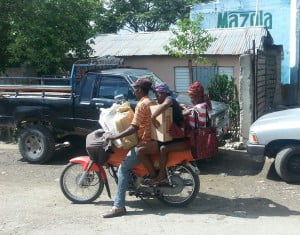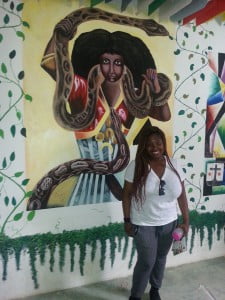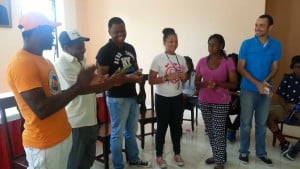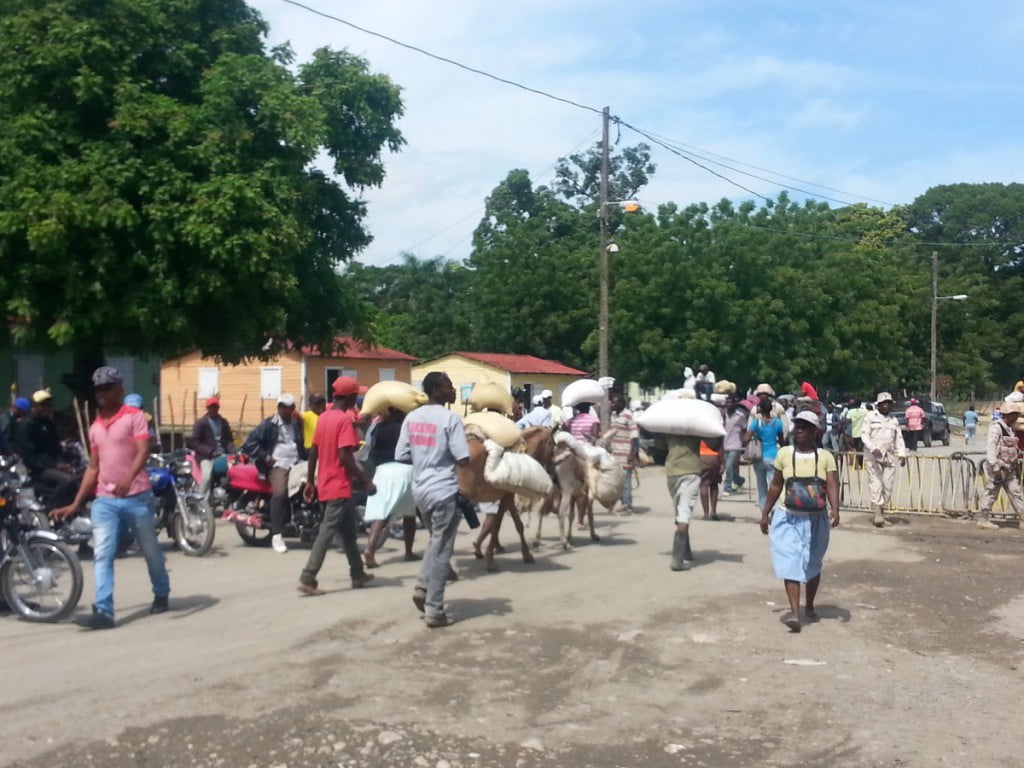Hello,

Transporting goods into DR
We apologize for the blog being posted late we have been having some technical issues with Wi-Fi. Yesterday was immigration day. As a part of immigration day we traveled to the border and got to go to the binational market that takes place every Monday and Friday. We also got the chance to speak with an organization that works in both the Dominican Republic and Haiti to ensure that discrimination does not happen and that all individuals are treated in a just way. Today Ana and I were the group leaders and decided to write the blog in a different format. So whenever you see AML that means that me Amanda Martin-Lawrence is speaking while when you see AH it is a signal that Ana Hernandez is speaking.
AML: As a child born from two Jamaican parents I consider myself to be Jamaican while also being African American. The way I Identify myself also changes When I walk through the airport I identify myself as American.
AH: I identify myself as a Hispanic who comes from two different but beautiful cultures. I am Puerto Rican by blood but Dominican at heart. It’s very hard when people have the ability to minimize your identity, because I myself would say that I am Puerto Rican, Dominican but also American raised.
 AML: Since I have been in the DR I have seen that the way you identify yourself is either to be Dominican or Haitian. While people do acknowledge the fact that a Dominican can be from Haitian descent it is simpler to just acknowledge them as Haitian. As long as at least one of your parents is Haitian you are to most of the world a full blooded Haitian. For some that can be a problem because while they are from Haitian descent they consider themselves to be Dominican. These people for the duration of their lives have lived as “Dominicans”, they live in the Dominican Republic, speak Spanish and connect to the culture. Most Dominicans who are from Haitian descent have never even been to Haiti. Even though I consider myself to be Jamaican I have never been to Jamaica. My whole life I have traveled around Europe and within the United States. If someone was to tell me that I am no longer American and that I should move to Jamaica I do not how I would feel or even how I would adapt to life there. Even though I have family that lives there the culture in Jamaica is not one that I am accustomed to or know.
AML: Since I have been in the DR I have seen that the way you identify yourself is either to be Dominican or Haitian. While people do acknowledge the fact that a Dominican can be from Haitian descent it is simpler to just acknowledge them as Haitian. As long as at least one of your parents is Haitian you are to most of the world a full blooded Haitian. For some that can be a problem because while they are from Haitian descent they consider themselves to be Dominican. These people for the duration of their lives have lived as “Dominicans”, they live in the Dominican Republic, speak Spanish and connect to the culture. Most Dominicans who are from Haitian descent have never even been to Haiti. Even though I consider myself to be Jamaican I have never been to Jamaica. My whole life I have traveled around Europe and within the United States. If someone was to tell me that I am no longer American and that I should move to Jamaica I do not how I would feel or even how I would adapt to life there. Even though I have family that lives there the culture in Jamaica is not one that I am accustomed to or know.
AML: One thing that I learned that really stood out to me was what the border actually looked like. When I think about a border I think of a large fence with barbed wire and strong military force. In my mind it also paints a picture of a place that is isolated and lonely. The Dominican Republic-Haitian border is an area full of so much culture. On Mondays and Fridays there is market a few feet away from the border in the same space there is also a museum that appreciates both cultures. The borders are in the center of town, Elias Piña. Today I learned borders do not have to be places that are scary but while that might be true there is injustice expressed. Another thing that I found interesting was the fact the U.S. Aid being sent to Haiti were the main things being sold in the market. As a group we learned in a seminar that not all aid is good since it takes away from the country’s economy while also not supporting the needs of the individuals in the community. While it may sound nice to donate shirts to children in Africa the reality is that donating a massive amount of T-shirts is not the greatest need in reality the people in the community may be better off with money to spend in a better manner. Being that aid is sent to a country as a way to help it surprises me that people resell it to make money that can actually help them.
 AML: For some it was an intense day since we had to walk through large crowds and had military officials present on our bus on the way back to San Juan. Seeing the market today was a beautiful thing to me. I have seen markets in my grandma’s town on Bedford, England and the Grand Army Plaza market on Saturdays. This market was very different because of the language barrier and the amount of people. In the market we saw people speaking in creole while there was also people speaking in Spanish. It was a little intimidating because there were a lot of people who each had a lot of merchandise that they were trying to sell. In this market it was not uncommon to be accidently pushed. People who attend this market have two main goals in mind: survive the day,and make as much money as possible to bring back to their families. As a group we knew that it was not an act of aggression or anger but instead a common norm of the market. A lot of people also left the organization we spoke to Res fronteriza feeling confused and eager to learn about the how we identify ourselves and how the Government bodies and constitutions identify people. For many the question became how can you not be considered a citizen and a part of the culture that you were born and raised in? As a whole we were interested in actually figuring out how to properly identify yourself, if there is a proper way too. Today also challenged us to think about the labels we give one another to identify ourselves and others. It also encouraged and challenged us to think about where the labels we use to describe and label each other actually comes from.
AML: For some it was an intense day since we had to walk through large crowds and had military officials present on our bus on the way back to San Juan. Seeing the market today was a beautiful thing to me. I have seen markets in my grandma’s town on Bedford, England and the Grand Army Plaza market on Saturdays. This market was very different because of the language barrier and the amount of people. In the market we saw people speaking in creole while there was also people speaking in Spanish. It was a little intimidating because there were a lot of people who each had a lot of merchandise that they were trying to sell. In this market it was not uncommon to be accidently pushed. People who attend this market have two main goals in mind: survive the day,and make as much money as possible to bring back to their families. As a group we knew that it was not an act of aggression or anger but instead a common norm of the market. A lot of people also left the organization we spoke to Res fronteriza feeling confused and eager to learn about the how we identify ourselves and how the Government bodies and constitutions identify people. For many the question became how can you not be considered a citizen and a part of the culture that you were born and raised in? As a whole we were interested in actually figuring out how to properly identify yourself, if there is a proper way too. Today also challenged us to think about the labels we give one another to identify ourselves and others. It also encouraged and challenged us to think about where the labels we use to describe and label each other actually comes from.

People crossing into and out of Haiti
One thing that surprised us was the way the Dominican Republic’s constitution goes against the Haitian’s constitution when talking about immigration. Because of this it leaves many to be nationless due to the fact that they cannot produce the many papers needed to prove the place of their birth and nationality. This is main problem here and the process for many is long and stressful.
Today our peers really proved that they could be responsible and intellectual individuals. As a collective we were able to ask the organization that fight for human rights and tries to help the problems that they face when dealing with discrimination. Everyone tried to asked though provoking questions and tried to uncover he real truth about being a nationless individual and how that could be possible by any nations laws.
AH: Being leader of the day was a great yet challenging experience on a day that required the most safety tactics. Being aware that I was responsible for keeping the group safe at all times and guiding them throughout the day made me very nervous because if anything went wrong throughout the day, I would be the one that the global glimpse family would point at. Everything went great, but I always believe that there is room for improvements while being “El lider del dia.” In the morning I made sure I woke up the glimpsers on time, repeated the warnings, repeated wake up calls, did headcounts frequently, which by the way were very successful and useful on this intense day. I made sure that we thanked guest speakers and anyone who helped or supported us throughout the day. I also made sure that those who were afraid or uncomfortable at checkpoints remained calm. I also made sure everyone was okay since the night before we had some sick Glimpsers. It was a good experience although I had to improve some safety tactics, I really enjoyed leading the whole group along with expanding on my leadership skills
AML: While Ana had a more positive experience being leader of the day I felt like I did not show my leadership skills as much as I could have. While I was sick with a sore throat Ana volunteered to be my voice and take a larger part in leading. Throughout the day we did split responsibilities such as leading the nightly meeting and ensuring that everyone was ready to go for their English class. While I did attempt to do my part I could not help thinking that I let down my group and Ana. During the day one thing that I did learn about myself was the fact that I try to own all mistakes as my own when really it was not my fault. As pair me and Ana had a successful day learned a lot about one other and the rest of our group.

Amanda and Ana it sounds as if you two were excellent leaders. You had an interesting. Thank you for sharing. Miss you Kaya!!! Hugs and kisses to you and Jewel.
Amanda and Ana it was very interesting to learn about the your Haiti/Dominican experience. Waling through a market place where people depend on others to sustain their living must have been very loud. I am glad that you were able to experience a safe and educational experience at the border. I am sorry to hear that some of the Glimpsers were feeling ill and hope for a speedy recovery. We miss you Cassidy and can’t wait to see you.
Amanda and Ana, this experience proved to be a challenging one for you and the Glimpsers. Having military personnel present in such a crowded area is stressful and something we here in the States are not used to seeing too often. I’m glad you were all able to pull through and complete your task as leaders for the day. I can’t wait to hear all about this when Cassidy returns home!
Amanda and Ana, thank you for your very informative and perceptive blog. I am impressed by your insights, sensitivity and understanding of the richness, value and dignity of the various cultures, and especially by your embracement of your own multicultural heritage. Clearly, you are both remarkable young women and strong leaders and I am proud of you. Impressive as always Amanda. Well done!
Aunt Lorna
Ladies, I ABSOLUTELY LOVE THIS BLOG!! Thank you for both sharing your unique voices and perspectives on the day and how those relate to your own identity. Here are 2 opinion pieces on statelessness in the DR and the currently immigration controversy that I wanted to share with you!
From the NY Times: http://www.nytimes.com/2015/07/12/opinion/stateless-in-the-dominican-republic.html?smid=tw-share&_r=0
The local perspective to the US media manipulation: https://www.facebook.com/ldemondesert/posts/10153374787526550
Ana and Amanda,
Thanks for painting such a vivid picture of your experience of the day. I’m looking forward to hearing more about your trip back in crew. Go Crew 506!
Amanda, you say you were disappointed in yourself as ELDD but one of the facets of being an ELDD is writing the blog and you and Ana knocked it out of the park! I agree with Carina, this is absolute gem of writing and describing an incredibly complex day and situation. I think both of your leadership skills are evident in your idea for your blog alone as this is unique and compelling at the same time. Thanks for brightening my day with the detailed description of yours.
Amanda, you have such interesting insights into membership, ethnicity, culture AND the needs of people in poverty. Keep following and questioning the treatment of Haitians in the DR. You’ve inspired me to read more about the strife between these nations.
Ana, it sounds like all your stellar camping skills have been put to the test! I’m sure your relentless optimism and visions of Bruno Mars at the top of the proverbial mountain motivated the group to carry on. Cannot wait to hear all about this transformative experience!